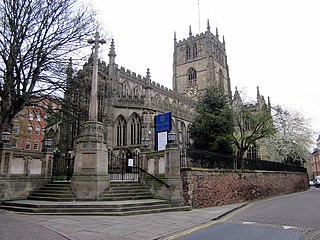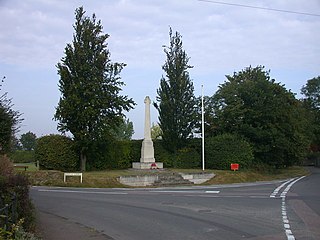West Hartlepool War Memorial or Victory Square War Memorial or Victoria Square Cenotaph is a war memorial in Hartlepool, County Durham, England commemorating those from West Hartlepool who died in World War I and World War II. The war memorial, created in the 1920s, is located on Victoria Road in Hartlepool's Victory Square. The square was created for this monument.

The County War Memorial, Nottingham is a Grade II listed structure in Nottingham.

Widnes War Memorial stands in Victoria Park, Widnes, Cheshire, England. It commemorates the serving men who lost their lives in the two world wars. The memorial consists of an obelisk in Portland stone on a plinth of York stone. It was unveiled in 1921, and more names were added in 1950. The monument is recorded in the National Heritage List for England as a designated Grade II listed building.

Moulton War Memorial stands in Main Road, Moulton, Cheshire, England. It consists of a marble statue of a soldier standing on a sandstone pedestal, and is surrounded by a wrought iron fence. The memorial was designed by Samuel Welsby, and unveiled in 1920. It is recorded in the National Heritage List for England as a designated Grade II listed building.

The Port Sunlight War Memorial stands in a central position in the model village of Port Sunlight, Wirral, Merseyside, England. The founder of the village and employer of its residents, William Lever, was anxious to have a memorial to commemorate those of his workers who had been lost in the First World War. As early as 1916 he commissioned Goscombe John to design a war memorial, which was completed and unveiled in 1921 by two of his employees. It consists of a granite runic cross with bronze statues and reliefs and has the theme "Defence of the Realm". On the memorial are the names of all of the company's employees who died as a result of both World Wars. It is recorded in the National Heritage List for England as a designated Grade I listed building.

The Royal Naval Division Memorial is a First World War memorial located on Horse Guards Parade in central London, and dedicated to members of the 63rd Division (RND) killed in that conflict. Sir Edwin Lutyens designed the memorial, which was unveiled on 25 April 1925—ten years to the day after the Gallipoli landings, in which the division suffered heavy casualties. Shortly after the war, former members of the division established a committee, chaired by one of their leading officers, Brigadier-General Arthur Asquith, to raise funds for a memorial. Progress was initially slow. The committee planned to incorporate its memorial into a larger monument proposed by the Royal Navy for Trafalgar Square. When the navy abandoned that project, the RND's committee decided to proceed independently. They engaged Lutyens, who, after negotiation with the Office of Works, produced a design for a fountain connected to the balustrade of the Admiralty Extension building.

Ashwell War Memorial is a war memorial cross in the village of Ashwell in North Hertfordshire, England. The memorial was designed by Sir Edwin Lutyens and unveiled in 1922, one of 15 war crosses designed by Lutyens to similar designs erected between 1920 and 1925. It is a Grade II listed building.

Trumpington War Memorial is a war memorial cross in the village of Trumpington, on the southern outskirts of Cambridge. The memorial was designed by Eric Gill. It was unveiled in 1921, and became a Grade II* listed building in 1999.

The British Thomson-Houston Company War Memorial is a First World War memorial in Rugby, Warwickshire, in the West Midlands of England. It was erected by the British Thomson-Houston Company in memory of the firm's employees who left to fight in the First World War and were killed in service. Designed by Sir Edwin Lutyens, it was unveiled in 1921 and is now a grade II* listed building.

King's Somborne War Memorial is a First World War memorial in the village of King's Somborne in Hampshire in southern England. The memorial was designed by Sir Edwin Lutyens and unveiled in 1921; it is a grade II listed building.

Stockbridge War Memorial is a First World War memorial in the town of Stockbridge in Hampshire in southern England. The memorial was designed by Sir Edwin Lutyens and unveiled in 1921; it is a grade II listed building.

The War Memorial is a Grade II listed structure located in the churchyard of the Church of St Laurence in the village of Stanwick.

The Royal Artillery Boer War Memorial is located on the south side of The Mall in Central London, close to the junction with Horse Guards Road at the northeast corner of St James's Park. Unveiled in 1910, it marks the deaths of the 1,083 soldiers of the Royal Artillery who died in the Second Boer War from 1899 to 1902 It has been a listed building since 1970.

The Dulwich Old College War Memorial is located in the forecourt of Dulwich Old College on College Road in Dulwich in the London Borough of Southwark. It marks the deaths of the former pupils of the college who died in the First World War between 1914 and 1919. The memorial is made from Hopton Wood stone and was designed by William Douglas Caröe. It was unveiled in 1921. It has been grade II listed on the National Heritage List for England since May 2010. The heritage listing places the memorial within a "visual and contextual relationship" with the Grade II listed Old College building and the entrance gates and piers of the Old College, also Grade II listed.

The Dulwich College War Memorial is located at the eastern front of Dulwich College on College Road in Dulwich in the London Borough of Southwark. It commemorates the alumni of the college who died in both the First and Second World Wars. The memorial was designed by W. H. Atkin-Berry, an alumnus of the college. It was unveiled on 17 June 1921, the Dulwich College Founder's Day, by Major General Sir Webb Gillman, and dedicated by the Dean of Durham, James Welldon. Gillman was an alumnus of the college, and Welldon had served as Master of Dulwich College from 1883 to 1885. It has been Grade II listed on the National Heritage List for England since May 2010. The heritage listing places the memorial within a "visual and contextual relationship" with the Grade II* listed Main College building.

Streatham War Memorial is a war memorial to the war dead of the London district of Streatham in the two World Wars. It was unveiled in 1922, and is sited near the northwest corner of Streatham Common.

A statue of Captain Albert Ball stands in Nottingham Castle Gardens, in Nottingham, England. It comprises a bronze sculpture by Henry Poole which depicts the British fighter pilot Captain Albert Ball VC DSO & Two Bars, MC accompanied by an allegorical female figure, standing on a stone pedestal by the architect Edwin Alfred Rickards. The memorial was unveiled in 1921, was listed at Grade II in 1972, upgraded to Grade I in 2017.

The Cyclists War Memorial is a war memorial on the village green in Meriden, West Midlands. The village between Coventry and Birmingham was long reputed to be at the geographical centre of England. The national memorial was built in 1920 to commemorate cyclists killed in the First World War. A bronze plaque was added in 1963 to commemorate cyclists killed in the Second World War.

Twickenham War Memorial, in Radnor Gardens, Twickenham, London, commemorates the men of the district of Twickenham who died in the First World War. After 1945, the memorial was updated to recognise casualties from the Second World War. The memorial was commissioned by Twickenham Urban District Council in 1921. It was designed by the sculptor Mortimer Brown, and is Brown's only significant public work. The memorial is unusual for its representation of a jubilant soldier returning home. It became a Grade II* listed structure in 2017.
The Bank of England War Memorial, in the internal Garden Court at the headquarters of the Bank of England in the City of London, commemorates the bank's staff who were killed while serving in the First World War and Second World War. It includes a bronze sculpture by Richard Reginald Goulden portraying Saint Christopher carrying the Christ Child. It became a Grade II listed building in 2017. The surrounding buildings of the bank are separately listed at Grade I.


















